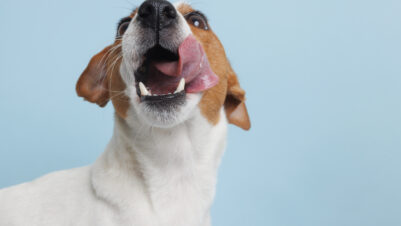CANINE OBESITY SHOULD BE VIEWED MORE AS A BEHAVIOURAL PROBLEM in the client than a medical issue for the animal, according to animal behaviourist Sarah Heath.
Speaking at VetsSouth 2016, she argued that it is only by modifying the clients’ beliefs and actions that vets can start to address the adverse health and welfare effects on the animal.
The root cause of a condition affecting increasing numbers of pet dogs and cats is that pet food is not just an energy source but a “social facilitator” and the means used by many owners to express their affection for the pet. So the role of veterinary practitioners and VNs was to understand and re-balance the relationship between clients and their pets, she said.
To do this, clinicians must listen carefully to what clients say about the way that they look after their pet. Claims, for example, that a dog is “fussy” or that “it will only eat human food” may provide useful insights into how the problem has arisen.
Such off-the-cuff comments will often give hints about the emotional atmosphere within the household and explain the cause of the anxiety that can result in dogs developing an abnormal interest in food. Moreover, owners will often misinterpret the dog’s behaviour as demanding food when it is actually seeking reassurance from their human companion, she said.
Another factor that is likely to promote excessive weight gain in pets is their owners’ inability to stop feeding treats even after discussing the need to reduce calorie intake. They may worry that a small quantity of dried kibble will not sustain their pet, yet may seriously underestimate the calories contained in a small piece of biscuit, she said.
Hungry and frustrated
Dogs that are only fed a small quantity of energy-dense pet food once a day are likely to spend much of their time hungry and frustrated, Sarah explained.
It may be better to offer smaller quantities at different times to encourage the dog to be more relaxed and less defensive about its food.
It is also less likely to stimulate the sympathetic nervous system response, which can increase the amount of food that is deposited as fat, she suggested.
The inability of most humans to see the world from the animal’s perspective causes further problems. The myth that humans need to be fed first to prevent the dog asserting “dominance” demonstrates a misunderstanding of canine social behaviour and when food is withheld from an already hungry dog it will suffer even greater discomfort.
Another human failing is the insistence of many pet owners that their dogs and cats should be fed at the same time and in the same place. “This means that they have to physically separate the dog that eats faster from the other’s bowl. How difficult would it be to feed them in different rooms?” she wondered.
One key difference between today’s obese pet and its leaner and wilder ancestor is the difference in the time and effort spent in hunting food. While puzzle feeding toys that gradually dispense small amounts of food can be useful in many animals, they are not a universal benefit.
Some dogs became over-excited or frustrated when using these devices, creating the opposite effect to the one intended. It is essential for pet owners to find other ways for healthy interaction with their pet. Rewarding the dog by increasing the time spent in play would bene t most obese dogs but this is not a panacea.
“Some dogs can become obsessed with a particular toy and will rely on it as a way of getting attention from their owner. This is why veterinary advice has to be directed to the individual – blanket recommendations can be quite dangerous as owners may misinterpret what you say.”
Veterinary staff were also warned that encouraging owners to spend more time exercising their dogs is not the solution to the obesity epidemic. Some pets may experience even greater anxiety when suddenly taken for long walks in unfamiliar surroundings and pushing the animal too hard, too soon may create new problems, such as musculoskeletal injuries.
A more gradual increase in exercise should bene t an obese animal’s long-term health and welfare. “But this has to be tailored to the individual needs of that animal and its owner. You can’t expect a single parent to find an hour each evening to go out and exercise their dog in the middle of winter – that is not going to happen.”
- Sarah Heath will be speaking this month at VetsNorth.








